So you're a new shooter and you've completed your first match, congratulations! You find the results listed on Practiscore, and you are immediately confused by what you see, and the more you look the more confused you get. Don't worry, we've all been there! The USPSA scoring model is fairly complex and there are many aspects of it to understand before the results will make complete sense to you. Let's take a look at some results and go over the basics to get you pointed in the right direction.
Here is an example of a past ENPS match result, we'll use this to explain the concepts:
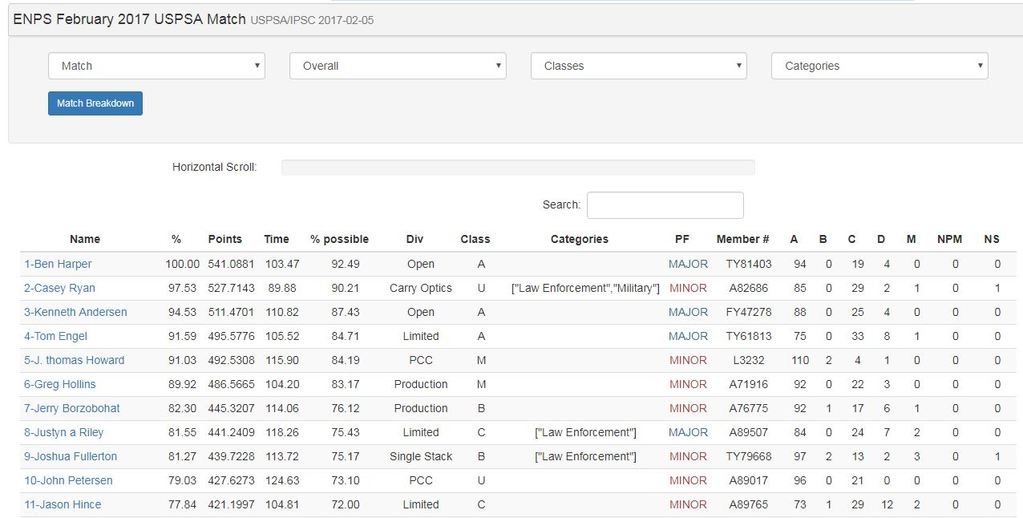
The first thing you probably notice is the competitor names listed down the left side in a ranking order with numbers next to them. That's the easy part, and you can probably deduce that the competitor with "1" listed at the top is the 1st place finisher, "2" is second place, etc. What you may not realize right away is that this ranking is specific to the Division selection made, which in this case is ALL divisions, also referred to as the "Overall" result. That is basically every competitor who shot the match regardless of what Division they were shooting, all lumped together. This result is mostly irrelevant for most shooters, other than the top finisher who is considered the "High Overall" (or HOA). But it's sometimes interesting to see how you finish in the overall scheme of the match. The results that really COUNT are the Division results, which means we need to filter the results down using the Division selection at the top, let's look an example of these results filtering down to JUST the Production Division:
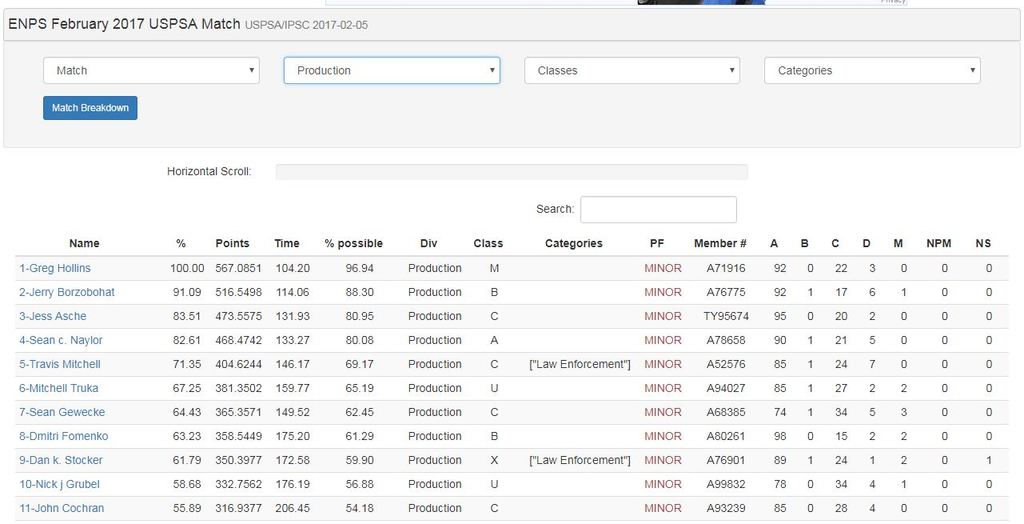
Now you'll notice the competitor who was listed a 6th Overall, is now listed 1st in the Production Division. This competitor would be considered the Production Division Champion at this particular match. If you look closer, you may also notice that the % and Points columns show different values for each shooter in this list than were listed in the Overall result. This is often a source of confusion and requires a basic understanding of the USPSA scoring model to explain.
Let's start with POINTS. Every stage in a USPSA match has a certain number and type of targets in it, either Paper, Steel or both. Paper targets are scored according to scoring zones on the targets and number of hits, and Steel targets are scored as hit or miss. Penalty points can also be applied for hitting no-shoot targets, missing targets, failing to shoot at targets, foot faults, and a whole lot of other things, which we won't go over here. Refer to the USPSA Rulebook for a complete explanation.
For basic scoring, Paper targets are scored using A-B-C-D scoring zones, and there are two types of targets "Metric" and "Classic".
Metric Target:
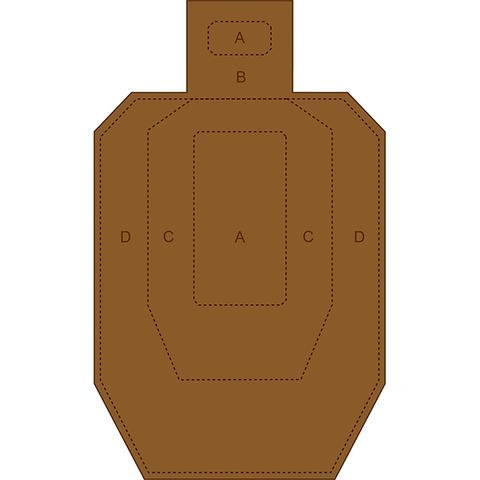
Classic Target:
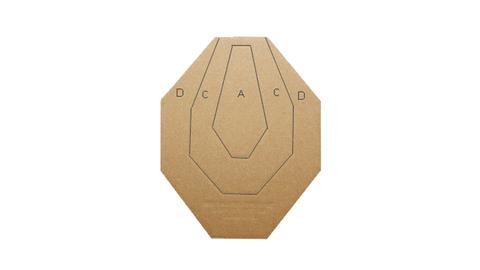
Notice the Metric Target has A-B-C-D zones, and the Classic Target has A-C-D zones. Scoring on these targets is determined based upon the Power Factor that the competitor is being scored under. Some divisions allow both Major or Minor power factor scoring based upon the ammunition being shot by the competitor, and other divisions are scored as Minor power factor only (Production, PCC, Carry Optics). Scoring is as follows:
| MAJOR POWER FACTOR |
MINOR POWER FACTOR |
| A Zone = 5 Points |
A Zone = 5 Points |
| B Zone = 4 Points |
B Zone = 3 Points |
| C Zone = 4 Points |
C Zone = 3 Points |
| D Zone = 2 Points |
D Zone = 1 Point |
You'll notice that A Zone is scored the same (5 points) regardless of power factor. But the B-C-D zones earn more points for Major power factor than they do for Minor power factor. We won't go into Major and Minor power factor here, other than to say you should be aware of what Power Factor you are shooting so you can make the appropriate choice when registering for a match. Refer to the USPSA web site for more information on Power Factor.
Steel Targets are essentially scored the same as an A Zone hit on paper (5 points). Steel targets in a USPSA match are always the "falling" type such as "Pepper Poppers" shown below, or steel plates on a rack or support post which can be knocked down/off:

For each stage, the stage briefing will list how many points are POSSIBLE for the stage, this is considered the 100% points level. That would be based upon A-Zone hits on all paper targets, and all steel being hit. The standard scoring is best 2 hits per paper target, unless the stage briefing indicates a different number. So let's go back and look at our example again, and this time we'll filter the results down to just ONE stage to make this easier to understand. Stage 1 from our sample match for the Production Division, and our sample Production Division Champion looks like this:

So let's say this stage had 105 possible points from 8 metric targets (best 2 hits scored) and 5 steel targets. If a competitor hit 2 A Zone hits on each of the 8 metric targets @ 5 points each, that would be 16 A Zone hits times 5 points = 80 points. If the competitor also knocked down all 5 steel targets, that would be another 5 times 5 points = 25 points. So the points total would be 105 points, assuming there were not penalties.
In the actual results, we can see in the Points column, that our sample shooter scored 95 points out of 105 possible. And looking over to the scoring zone scores on the right side of the results, we can see exactly how this score was calculated.
A Zone (includes Steel targets hit) = 17
C Zone = 3
D Zone = 1
Based upon the Division the competitor was in (Production) we already know the scores would be based upon Minor power factor, but that is also listed under the PF column specifically.
17 A Zone hits @ 5 points = 85 Points
3 C Zone hits @ 3 points = 9 Points
1 D Zone hit @ 1 point = 1 Point
Total Points: 95 Points, which is what we see listed under the Points column.
This particular example has no PENALTIES earned, but you will see columns listed at the end for penalties: M (Miss or "Mike"), NPM (No-Penalty Miss) and NS (No-Shoot). An M "Mike" means a target was not hit, either a bullet not in the scoring zone on paper or steel not knocked down. The penalty for a Miss is 10 points. NPM is a special non-scoring penalty that doesn't impact score and is only used in certain specific stage design cases which we won't cover here. The penalty for a hitting No-Shoot target is 10 points. In the event there were penalties earned by a competitor during a stage, those penalties are subtracted from the actual points shot on the stage, before calculating the Hit Factor. The bottom line on penalty points is they are very punitive, and can have a significant negative impact on your score!
So hopefully that is easy to understand now how the ACTUAL points shot by a competitor are calculated. Now we need to also consider the time the competitor took to finish the stage in calculating the score. This calculation is done using a calculation method called HIT FACTOR ( the "HF" column in the results). Hit Factor is simply the number of points the competitor shot, divided by the time it took them to earn those points. An easy way to think about Hit Factor is "Points Per Second". So for our sample competitor, he finished the stage in 18.91 seconds and earned his 95 points. 95 divided by 18.91 gives us a Hit Factor of 5.0238, which you see listed in the HF column. The Hit Factor is the ACTUAL score used to rank competitors in the results. A competitor who shot more points, but took longer to do it, may end up behind another competitor in the results who was less accurate but shot faster.
This balance between accuracy and speed is the fundamental challenge of our sport! Any good competitor could hit every A-Zone and knock down every piece of steel in a stage given no time limit. And any good competitor could blaze through a stage firing shots at every target very quickly if the actual hits weren't counted and all they had to do was fire shots AT the targets. But the combination of speed AND accuracy is the real challenge, and is the reason why HIT FACTOR is used for scoring since it represents this balance.
So back to our results, the way it works for scoring within a division for a stage is that the competitors are ranked in HIT FACTOR order, then the TOP competitor in 1st place for Hit Factor is awarded 100% of the POSSIBLE points in the stage. Note this is NOT how many points they actually SHOT in the stage, it is 100% of the POSSIBLE points. In our example, that was 105 Points possible, so even though our sample 1st place shooter only shot 95 ACTUAL points, after the hit factor was calculated and he was ranked 1st, he was awarded 105 STAGE POINTS, listed in the "Stg Points" column in the results. You will also notice his % is listed as 100% confirming he was awarded all of the possible points in the stage.
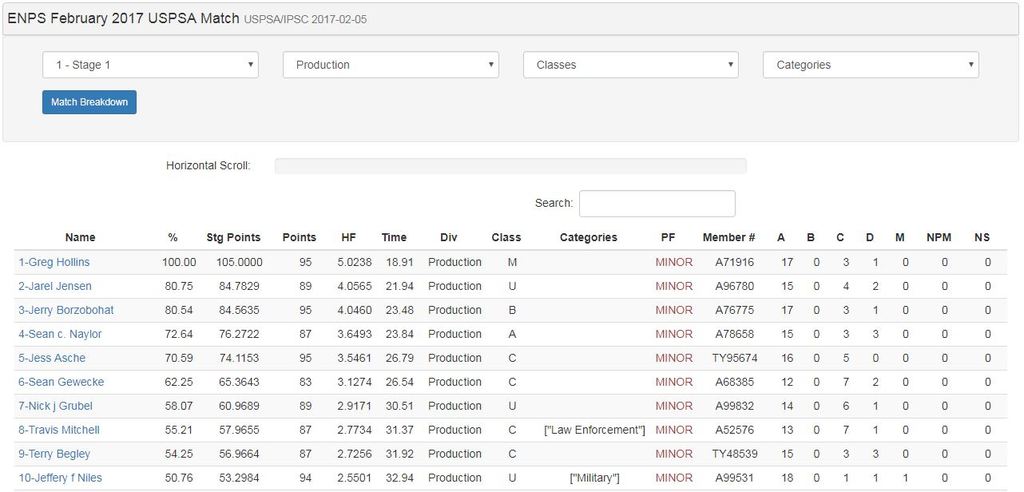
Each of the competitors below the top shooter are then ranked as a % of the top shooter based upon their Hit Factor. So our 2nd Place competitor on this stage had a HF of 4.0565, which when divided by our 1st Place competitor's HF of 5.0238 comes to 80.75%, which you will see listed in the % column next to the 2nd place competitor. That competitor earns 80.75% of the POSSIBLE points on the stage, or 84.7829 points, which is listed in the Stg Points column.
So that's pretty much the basic scoring model for each stage in the match. Each competitor's Hit Factor is calculated, they are ranked compared to the top competitor in the division for that stage, and everyone is awarded STAGE POINTS based upon their hit factor as a percentage of the top finisher's hit factor.
Then the last piece of the puzzle is calculating the actual MATCH results. This is really pretty easy to understand once you understand how each STAGE result is calculated. The Match Points are simply calculated for each competitor by adding up all of their individual Stage Points. The competitor with the highest number of Match Points wins the match for that Division. So as you can see it's quite possible for a competitor to win a STAGE but not win the MATCH. It's even possible for a competitor to win the MATCH without ever winning an individual STAGE. Consistency over the course of a match is of utmost importance in determining the MATCH winner.
Taking this back to the beginning again, let's reference our OVERALL match results one more time:
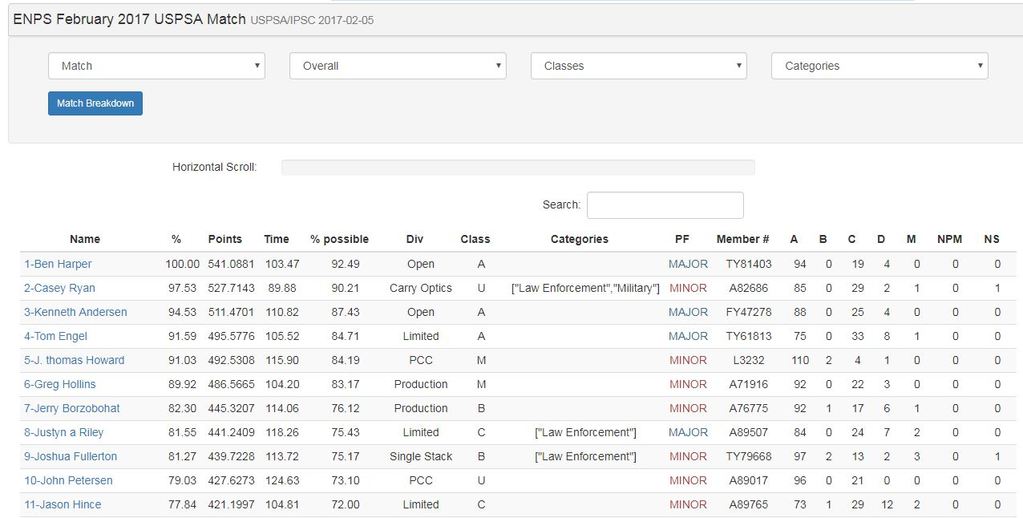
As you can see, our sample Production Division champion for the match, has completely different % and Points scores listed in the Overall result than he had in the Division result for the Production division. That is because the Overall result is calculated based upon each STAGE individually to award Stage points in the result, and those are added up to determine the Overall match points. It's essentially the exact same process we went through above to calculate the Production division match results, only with ALL shooters in the match included in each stage calculation. Based upon some competitors being scored with Major scoring and some with Minor scoring, you can probably see how this calculation is really of little value, which we mentioned at the beginning. Other than one competitor being awarded the High Overall (HOA) at some matches, there is really no attention paid to Overall results, it's the Division results that really matter and are how prizes are awarded at major matches.
So there you have it, hopefully this gives you a better understanding of the complex subject of USPSA scoring and you can now interpret your Practiscore match results with confidence!